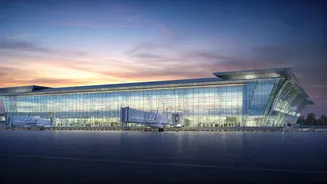Infrastructure and Expansion
The Ayodhya Airport is undergoing significant infrastructural advancements aimed at boosting its capacity and efficiency. These improvements encompass
the expansion of the terminal building to accommodate a greater influx of passengers. Enhanced facilities, including modern check-in counters, security checkpoints, and baggage handling systems, are being installed to improve passenger convenience and operational effectiveness. Furthermore, the airport is working on extending its runway to facilitate the operation of larger aircraft and increase flight frequencies. These upgrades not only enhance the airport's operational capabilities but also ensure that it aligns with global aviation standards, fostering a safer and more seamless travel experience for all passengers. The airport's commitment to these infrastructural upgrades shows its dedication to becoming a major aviation hub, attracting more airlines and boosting the city's connectivity.
Strategic Significance Unveiled
Ayodhya Airport's strategic importance extends far beyond its role as a transportation hub. Its location is crucial, offering enhanced connectivity to key religious sites and tourist destinations, thus boosting tourism. This accessibility is likely to encourage both domestic and international visitors, stimulating local economies through increased spending on hospitality, retail, and local crafts. Moreover, the airport's development serves as a catalyst for overall regional development. The presence of a well-equipped airport typically attracts investments in infrastructure, real estate, and other related sectors, fostering job creation and economic growth. This infrastructure also promotes the integration of Ayodhya with national and international markets, creating opportunities for businesses and enhancing trade. The strategic importance of the airport is therefore not only reflected in its ability to connect people but also in its capacity to stimulate comprehensive and sustainable growth across various sectors.
Boosting Tourism and Economy
The construction of the Ayodhya Airport has significantly contributed to boosting tourism and the local economy. The enhanced connectivity has made it easier for tourists to visit the city's religious sites and cultural landmarks, attracting more visitors. This influx of tourists has directly benefited the hospitality sector, with hotels, restaurants, and other tourist-related businesses experiencing increased demand and revenue. This tourism growth has also led to the creation of employment opportunities for the local populace. The airport has further incentivized the development of auxiliary industries such as transportation services, retail, and the sale of local handicrafts, all contributing to the economic vitality of the region. The airport's role in attracting investment, promoting trade, and creating a supportive ecosystem for small businesses further underpins its importance in fostering sustainable economic progress for Ayodhya.
Future Development and Plans
Looking ahead, the development plans for Ayodhya Airport involve further expansions and improvements. The intention is to introduce more passenger facilities and amenities to elevate the travel experience, including expanded lounge areas, more retail outlets, and upgraded passenger services. Furthermore, there are proposals to add new flight routes and increase flight frequencies, facilitating greater connectivity to other significant cities and international destinations. These future developments are anticipated to increase the airport's capacity to handle a greater number of passengers and flights, fortifying its position as a major aviation hub. Simultaneously, these expansions will likely stimulate economic activities, encouraging more investment in Ayodhya and its adjacent regions. The plans underscore a commitment to continued growth and the airport's integral role in the city's and the surrounding areas' ongoing development.












